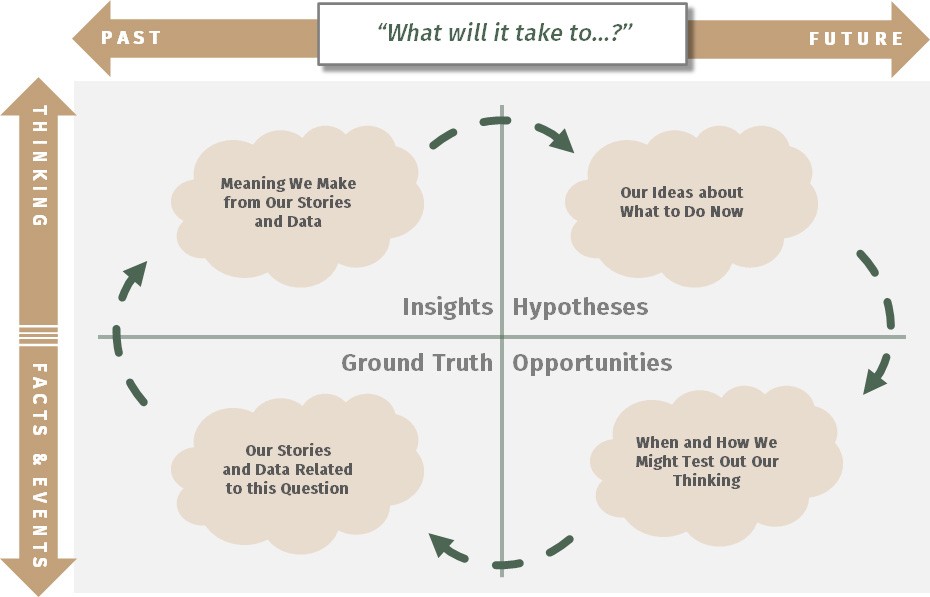Learning Tables are a dynamic tool designed to foster collaborative learning and knowledge sharing within and across teams. They provide a structured framework for groups to converge around a shared question and collectively explore their existing knowledge in order to drive future action.
At its core, a Learning Table is represented by two intersecting axes, with a central question serving as the focal point. This framework can be sketched on paper, a whiteboard, or utilized through digital collaboration platforms.
The vertical axis distinguishes between time – with the past situated to the left and the future to the right of the present moment, represented by the line itself. The horizontal axis divides the table into two realms: the upper section is dedicated to ‘thinking’ – the interpretation and meaning-making derived from data and actions – while the lower section is reserved for ‘action’ – the tangible data collected, steps taken, and future plans. This deliberate separation encourages a balanced approach to problem-solving and strategic planning.
 Diagram illustrating table conversations and the central framing question
Diagram illustrating table conversations and the central framing question
This introduction to the Learning Table methodology will equip you to effectively engage in and contribute to collaborative learning sessions. While the structure of a Learning Table is straightforward, mastering its application is a nuanced skill. For those seeking to deeply integrate this practice, seeking guidance from a certified Learning Table practitioner is highly recommended to tailor its use to specific objectives and challenges.
Learning Tables are particularly effective in facilitating learning-oriented discussions grounded in empirical data and practical experiences. They encourage a deliberate slowing down of the thought process, making it more transparent and accessible to all participants. For individuals who tend towards abstract thinking, Learning Tables help anchor their ideas in concrete actions. Conversely, for those who are quick to implement solutions, this tool provides a valuable pause for reflection on the underlying rationale driving their actions.
When is a Learning Table the Right Choice?
Employ Learning Tables when you need to unite a group around a common inquiry. This method is ideal for reflecting on past experiences, analyzing data or research findings, and collectively extracting lessons learned to inform future endeavors. It’s important to note that Learning Tables are not about forcing consensus on a single solution. Instead, they are intentionally designed to cultivate individual agency and stimulate innovation, empowering each participant or team to identify and test ideas most relevant to their specific context and responsibilities. Consider using Learning Tables to:
- Initiate a new project or venture.
- Facilitate cross-learning and comparison of strategies across different teams or departments facing similar challenges.
- Conduct project retrospectives to capture key learnings for subsequent projects or broader organizational knowledge.
- Structure workshops or conferences to harness the collective expertise present in the room, ensuring maximum knowledge exchange and impactful outcomes.
Learning Table sessions can range in duration from concise hour-long meetings to more in-depth multi-day workshops. They are adaptable to groups of varying sizes, from pairs to large teams, and can be used iteratively to continuously incorporate data from diverse sources, supporting ongoing reflection and experimentation within an organization. Imagine a scenario where a broad question, like “How can we enhance student engagement in online learning?”, is posed, and individuals are invited to contribute their insights and experiences to a shared Learning Table over time.
Participating in a Learning Table Conversation: Key Principles
A fundamental principle guiding Learning Table conversations is the concept of “Experts in Equal Measure.” The objective is not to champion personal viewpoints but to collectively broaden the scope of understanding for everyone involved. The true power of a Learning Table emerges when all participants willingly contribute their unique experiences – successes, setbacks, unexpected obstacles – and maintain an open curiosity towards different data points and experiences, whether they align with or challenge their own. Often, the most profound insights into achieving a goal are hidden within the challenges and failures encountered along the way. If there is pre-session preparation, such as reviewing a report or preparing a story to share, active participation is crucial as the quality of the conversation directly depends on the preparedness of each contributor.
Before engaging in a Learning Table session, proactively identify a real, practical opportunity in your upcoming work where you could apply a valuable insight or idea gained from the discussion.
Another core principle is the emphasis on diverse voices. The perspective of a new team member can be as transformative as that of a seasoned veteran. During sessions, actively ensure that all voices are heard and all experiences are valued. Pay particular attention to dissenting opinions or counter-examples – instances where a similar approach yielded significantly different results. Investigate these discrepancies to uncover valuable learning opportunities. Recognize that individuals may interpret the same experiences differently and derive varied lessons from them; this diversity of interpretation is a strength to be explored.
Beyond the Quadrants: The Essence of Learning Tables
It’s important to understand that the true value of a Learning Table conversation is not rigidly confined to the drawn quadrants themselves. The methodology is fundamentally about fostering a deliberate and thoughtful dialogue. It’s about posing meaningful questions that resonate with the group and sharing individual narratives to illuminate different perspectives. It’s about consciously distinguishing between objective facts and subjective interpretations of those facts. It’s about dedicating balanced time to both reflecting on past experiences and envisioning future possibilities. And crucially, it’s about ensuring the conversation extends beyond the session itself, translating emergent ideas into tangible actions and experiments in the real world.
